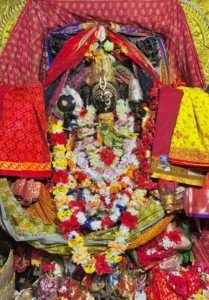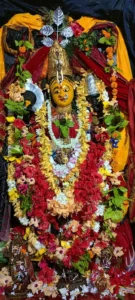In the quaint tiny village of Kakatpur, Odisha, where the river Prachi with its sacred soil, stands a temple of Maa mangala with centuries worth of living devotion. The Maa Mangala Temple isn’t just a place of worship, it’s a sanctuary where devotees worship.
This is one of the very few temples where age-old customs have remained and haven’t faded into the background. Instead, these customs are fiercely preserved, protected and celebrated.
In this guide, we walk through Maa Mangala temple rituals, the significance of daily pujas, and the divine Arti, an experience that transforms your life.

Table of Contents
ToggleGoddess Maa Mangala
Before understanding the rituals, one must grasp who Maa Mangala is to her devotees. Goddess Maa Mangla is considered a powerful form of Shakti. It is believed that she protects, heals, and guides her devotees with pure intention. Goddess Maa Mangala is both, she destroys and nurtures, disciplines and blesses. This duality reflects in every ritual performed in her honor.
Daily Pujas
The temple does daily pujas, a cycle of offerings and prayers that begin before dawn and continue until nightfall.
1. Mangalalati (Morning Ritual)
At the first stroke of the Sun , the doors of the temple open to the Mangalalati which is the earliest offering of the day. This is when the goddess is gently awakened with soft pooja and incense.
2. Abhisheka (Sacred Bath)
One of the most significant moments in Maa Mangala temple rituals is the ceremonial bathing of the idol. Water, milk, honey, turmeric, sandalwood, and sacred herbs are poured over the deity, symbolizing purification.
3. Naivedya (Food Offering)
After the bath and dressing in fresh clothes, the goddess is offered a variety of local foods—steamed rice, sweets made from jaggery and coconut, and seasonal fruits. Nothing is extravagant, yet everything is offered with love, making it divine.
4. Madhyahna Puja (Midday Ritual)
This puja involves reciting mantras from the Durga Saptashati and Lalita Sahasranama, with lamps lit and gongs resounding through the sanctum. It’s said that prayers offered at noon are especially powerful, as the sun’s energy is at its peak, matching the goddess’s radiance.
5. Sandhya Arti (Evening Offering)
As dusk falls, the Sandhya Arti marks the transition from light to shadow. Lamps are waved before the deity while conch shells and cymbals fill the air. For many, this is the most moving part of the daily pujas, evoking a sense of surrender and stillness.
The Special Mangala Arti: Fire and Devotion
Though every puja is an offering, the special Mangala Arti holds a place of its own.
Conducted on Tuesdays and during specific lunar phases, this Arti is unlike any other. It involves the use of multiple lamps—some with 108 wicks—creating a wall of golden flames that dance before the goddess. The flames aren’t just fire; they’re expressions of longing, gratitude, and protection.
Devotees say that witnessing this Arti cleanses the heart. The energy in the sanctum becomes thick, charged, and difficult to describe. You don’t just watch it—you feel it. The rhythmic chanting, the heavy aroma of burning camphor, and the collective devotion create a sacred vortex that draws everyone inward. Locals believe that wishes whispered during this Arti rarely go unheard.
Festivals: When Rituals Come Alive
While the daily pujas form the backbone of temple life, it is during the festivals that the temple truly comes alive. These are not events for spectacle—they are extensions of faith that reach deep into the village’s cultural and spiritual soul.

1. Jhamu Yatra (Fire Walk Festival)
Perhaps the most intense expression of devotion at the temple, this annual festival sees male devotees, known as ‘Bhaktas’, walk barefoot across burning embers to please Maa Mangala. It is not about spectacle or thrill. Each step taken on the fiery path is a prayer, a sacrifice, and an offering.
Before the walk, Bhaktas undergo strict fasting and purification. During the ritual, not one expression of pain is seen—only devotion, surrender, and belief that the goddess will protect them.
2. Pana Sankranti (Odia New Year)
This festival celebrates new beginnings and the nurturing aspect of the goddess. Sweet drinks made from jaggery, coconut, and bael leaves are offered to Maa. The belief is simple: just as she quenches thirst in the heat, she cools down life’s harsh moments.
3. Navaratri
The nine nights of worship are observed here with unique fervor. Each night, a different form of the goddess is invoked. Devotees fast, sing bhajans, and spend the nights within the temple compound. The special Mangala Arti during Navaratri draws hundreds, often leaving the temple brimming with emotion and chants that linger even after the bells stop.
The Role of Ritual in Modern Faith
In today’s world of rush and reason, ancient practices are often dismissed as outdated. But the Maa Mangala temple rituals serve as a gentle reminder: that ritual isn’t repetition—it’s remembrance. It’s about staying grounded in gratitude, aligning with something bigger than the self, and carrying faith into the everyday.
Even young people in the area, far from being disconnected, are active participants—recording the chants, documenting the history, and ensuring these rituals remain alive not just in memory but in motion.
Final Reflections
The beauty of Maa Mangala Temple isn’t just in its structure—it lies in its pulse. A pulse kept alive by daily pujas, vibrant festivals, and especially the special Mangala Arti that bathes the goddess in firelight and the people in faith.
This temple teaches us that rituals, when done with love and meaning, don’t just honor the divine—they transform us. And if you ever find yourself standing there, bell echoing in the distance, the scent of flowers and camphor in the air, know this: you’re not just a witness—you’re part of a sacred rhythm that’s been playing for centuries.


